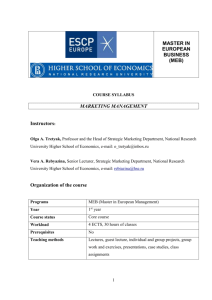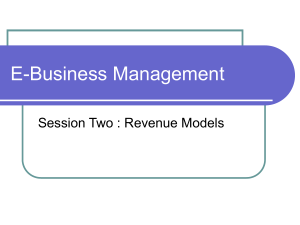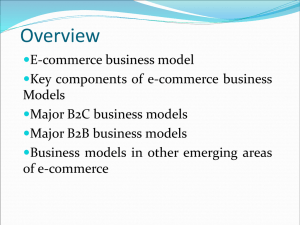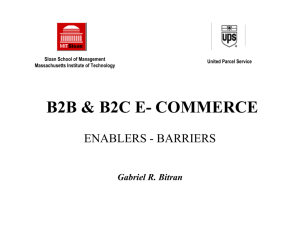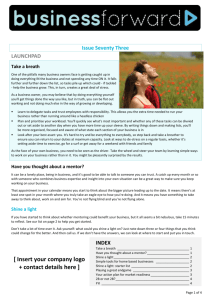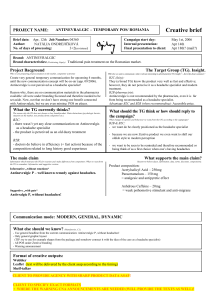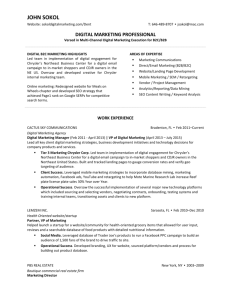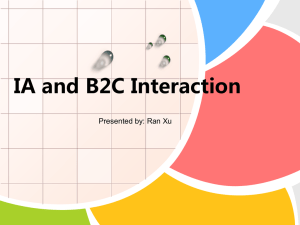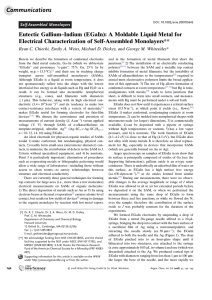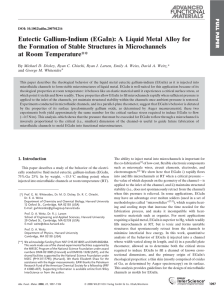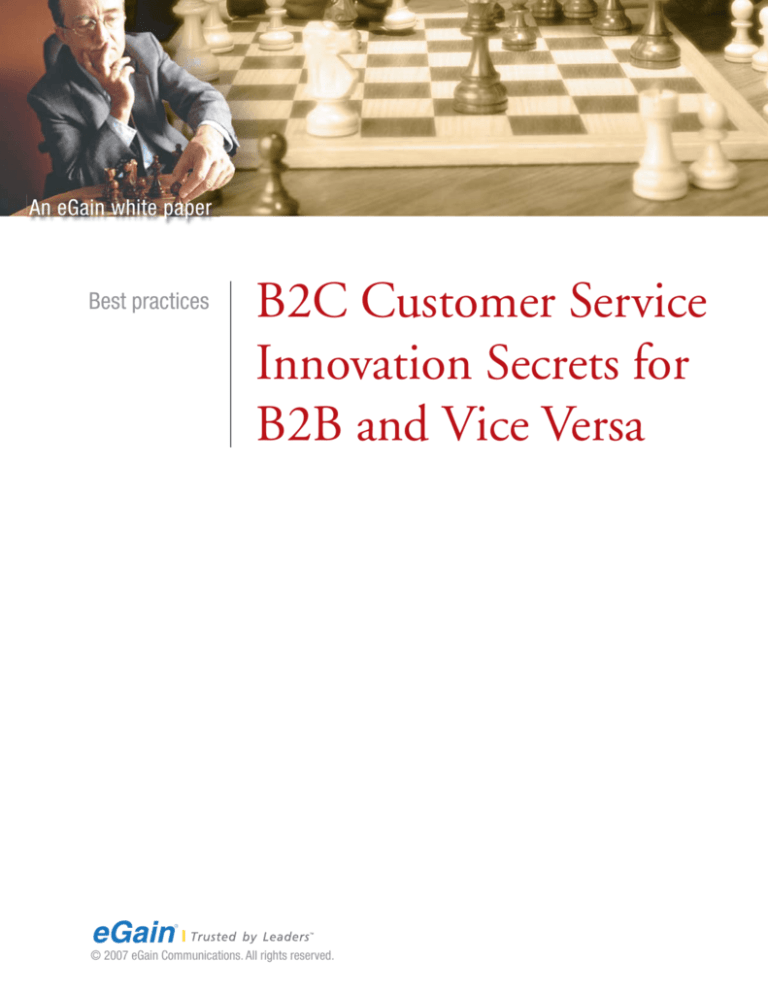
An eGain white paper
Best practices
B2C Customer Service
Innovation Secrets for
B2B and Vice Versa
© 2007 eGain Communications. All rights reserved.
Customer service takes on a variety of flavors based on the nature of the given
business and its target market. Among examples are B2B (business to business), B2C
(business to consumer), B2E (business to enterprise), B2A (business to anyone), O2B
(outsourcer to business), O2C (outsourcer to consumer), G2C (government to citizen),
C2C (consumer to consumer), and service chains such as B2B2C (business-tobusiness-to-consumer). These categories of customer service have mostly followed
independent paths in their evolution. However, there has been some convergence and
cross-pollination of ideas, innovations, and best practices across these categories.
One of the drivers of this convergence is the fact that all of us, including business
managers, are consumers, too. We carry our consumer habits and expectations into
the workplace, and this includes the way we like to access and use information.
Gartner predicts that “consumerization” of IT will be the most significant IT trend
during the next 10 years! In IT consumerization, innovation begins in the consumer
world and makes its way into the enterprise.
On the other hand, B2B innovations and service processes are often designed to be
robust because each client and service transaction represents a much larger financial
value to the enterprise. B2C businesses that are at the cutting edge of superior
customer service are incorporating these practices to further extend their competitive
advantage.
At eGain, we have worked with blue-chip clients around the world, implementing a
variety of customer service systems. These clients are differentiating themselves in the
market by cross-leveraging high-impact B2C approaches in B2B customer service
and vice versa. This white paper outlines what these innovations and best practices
are, and how you can exploit them to deliver unique customer experiences, improve
customer loyalty, and reinforce your brand.
B2C innovations for B2B
1. Add a human touch when you automate online interactions
B2C customer service has long been driving user interface innovation since
ease of use is critical to adoption. As an example, chat bots (also called
virtual agents, avatars, concierges, automated chat, etc.) with natural
language processing have delivered superior customer experience and
tangible cost savings in B2C customer service. Many of our financial
services clients use this approach to provide automated web self-service that
has a human touch, while embellishing their brand image. One of these
clients uses a chat bot with the same persona as an actor, who features in
their television ads, in order to create a unified multichannel brand
experience, and increase website stickiness and sales. A premier insurance
client in the US answers consumer questions on billing, claims, procedures,
policies and offerings using a chat bot.
Examples of cross-leverage in B2B:
! A large multinational bank, also an eGain client, took this approach and
deployed it successfully in a B2B scenario. Their chat bot helps over
4000 corporate clients in using cash management applications.
! A teleconferencing equipment manufacturer implemented a chat bot
with a cartoon-like persona to make it easy for non-technical business
customers to get their questions answered. These customers had been
getting frustrated with the hundreds of hits they were getting from
website search, finding it impossible to wade through the search results
to find answers.
2. Exploit consumer-centric interaction channels and rich media
Emerging electronic channels such as chat, cobrowsing, and SMS are used
more in B2C than B2B environments. As business customers bring these
habits and preferences to the workplace, these channels are becoming
increasingly relevant in the B2B context. Use of relatively new electronic
channels such as SMS is driven by mobile workers, the continued blurring of
the workplace and home and generational preferences, while broadband
3
adoption is driving the popularity of web cobrowsing and rich media. A
recent survey of the members of the Society of Service and Support
Professionals (SSPA), an association with a significant number of B2B
customer service managers in its membership, found that interactions
through electronic channels finally surpassed phone interactions in 2005.
Examples of cross-leverage in B2B:
! A large office supplies retailer, an eGain client, uses chat and cobrowsing
to provide superior experience and maximize online sales to not only
consumers but also its business clients.
! An international banking client uses chat and cobrowsing to show rich
informational content and train business clients on how to use treasury
management applications.
3. Leverage in-process guidance to maximize interaction value and
enforce compliance
Guided interaction execution through an adaptive dialog, driven by a
reasoning engine, has been traditionally used in B2C customer service for
troubleshooting consumer electronics products such as PCs and appliances.
In this approach, the consumer starts by stating a symptom of a problem and
the guidance system takes the end-customer or the agent speaking to the
end-customer through an intuitive dialog to a resolution.
In-process interaction guidance technology is used in B2C situations for
intelligent recommendation of a product or service in a new sale scenario.
For instance, an eGain client uses guided web self-service that asks openended lifestyle questions to suggest appropriate cell phone models to
consumers. The system is also used for upsell and cross-sell of related
products and services in the context of new sales to maximize the value of
the initial sales transaction or at the conclusion of successful post-sales
customer service interactions for incremental expansion of consumers’
wallet share. Sophisticated customer service systems that use the customer
interaction hub (CIH) approach, where multichannel interaction
management capabilities are built on a common CIH platform that
includes rules, workflows, and knowledge management, can even initiate
fulfillment tasks with service levels associated with them during or at the
4
end of guided interactions. Furthermore, the reasoning engine can ensure
compliance with organizational best practices and government regulations,
which is particularly important in an environment of constant agent churn
and the contact center outsourcing tsunami. With in-process customer
interaction guidance systems, many B2C businesses have realized stunning
ROI in areas such as the following:
! Improved first-contact resolution
! Improved agent effectiveness and efficiencies
! Reduction of agent training requirements
! Increased revenue generation
! Reduction of unwarranted product returns and field visits
B2B clients are now using this approach and are realizing similar results in
both agent-assisted service and self-service. An example is:
! A premier European bank, an eGain client, uses in-process agent
guidance to help small businesses open new accounts. While this
process required domain experts with seven years of experience in the
past, the interaction guidance system now allows customer service
representatives with just one year of experience to perform the task - an
85% reduction in training time!
4. Generate revenue from marketing and sales through POS (point of
service) captive marketing
In the age of limited attention span, advertising fatigue, unlisted phone
numbers, “do not call” regulation, easy call avoidance enabled by caller ID
and over-zealous spam filters, marketing and sales organizations are
wrestling with the daunting challenge of how to expand market reach, find
leads and accelerate revenue growth. Savvy B2C businesses have figured out
how to mitigate this issue. They are exploiting the only real captive
customers that pay attention to the supplier to advertise an offering, make a
new sale, cross-sell, and upsell:
! The ready-to-buy prospective consumer, who is asking for information
and advice from you related to your products and services.
5
! A current customer, who is trying to fix a problem with a product or
service she or he has already purchased.
There is a high likelihood that these captive consumers are receptive to
interacting with the business. Industry statistics reveal that 75% of emails
related to customer service are opened by customers, while spam filters
choke off over 98% of unsolicited email promotions. Among the emails that
do get in, an open rate of less than 10% is quite common. Given these
gloomy statistics from a marketing standpoint, it only makes sense to add
POS marketing as one of the key demand generation activities to any
supplier's marketing mix. Innovative B2B companies are now starting to
exploit this approach.
5. Maximize customer service RAS (reliability, availability, and
scalability)
While this is more of a strategy and best practice than an innovation, B2C
companies pay a lot more attention to their customer service and commerce
systems being up and running on a non-stop basis than B2B. B2C businesses
are far more visible to the public than B2B and so are issues with their
systems, and moreover, they affect a much larger set of customers than B2B.
Horror stories about top retail websites being down on “Black Friday” (the
Friday after Thanksgiving in the US) predictably come out every holiday
season. So are stories of utility company websites and customer service
systems being down when consumers look for life-critical information on
their websites during natural disasters. Burned by bad publicity, B2C
companies have historically paid more attention to the reliability,
availability, and scalability of their customer service and commerce systems.
Moreover, some industry sectors such as B2C financial services have paid
more attention to this area because of the financial nature of transactions
and interactions and the large number of customers impacted.
! For instance, a premier asset management firm, an eGain client, has
reinforced its customer service RAS by setting up a distributed-server
installation. B2B service leaders are now starting to use RAS as a key
differentiator.
6
B2B innovations for B2C
1. Provide value-based service
Providing the right level of service to customers based on their value to the
business is a high-impact best practice that is used in B2B environments,
albeit sporadically. Consumer-centric businesses hardly ever provide tiered
service to their customers based on their historic value to the business or the
size of a sales transaction. With ever-thinning operating margins and
escalating service costs, B2C businesses can no longer afford to provide the
same level of service to all their possible customers.
As an example, factors such as the potential value and profit margin of a
sales transaction can be among the many factors used in prioritizing salesrelated requests coming from prospective consumer clients (Figure 1).
Figure 1: Service delivery framework based on sales opportunity
Likewise, past revenue and profitability of a consumer can be among factors
in processing post-sales service requests (Figure 2).
7
Figure 2: Service delivery framework based on customer value
Examples of cross-leverage in B2C:
! One of the world’s largest telecom companies, an eGain client, routes
phone calls and emails from low-value consumers (based on the value of
past purchases) to offshore, outsourced agents and requests from highvalue customers to seasoned in-house agents.
! A leading brokerage firm and one of the world’s biggest asset
management companies, both eGain clients, route emails from
consumers with high net worth to a special queue serviced by
experienced agents, who can provide faster service levels.
! A large retail client in the US offers chat customer service when the
consumer's shopping cart reaches a certain threshold value.
2. Promise service levels and deliver on them
The ability to set customer service expectations and fulfill the service
promise is starting to become the central component of brand equity and
customer loyalty in both B2C and B2B markets due to relentless global
competition and product commoditization. This is evidenced by research
findings such as the ones listed below:
! 46 percent of respondents in a 2006 consumer survey quit doing
business with a company as a result of poor service. (2006 Accenture
survey of 1,000 consumers)
8
! If a customer service inquiry with an online store failed to be resolved
via online self-service, 62 percent of customers in a 2005 survey said
they were less likely to buy from that store again. (2005 JupiterResearch
consumer survey)
! “Firstly, the expectation is that an IT equipment partner should be a
one-stop shop for their IT needs and secondly, that they should offer
outstanding service/support.” (2006 ACNielsen IT Growth & Brand
Positioning Study, Survey of 1,680 senior IT decision makers in U.S.
and Europe)
Historically, B2B companies have embraced the concept of service level
management and delivery since it is a fundamental requirement to
participate in B2B markets. B2C companies that leverage this B2B best
practice can truly stand out in customer service and reap dividends in the
form of increased sales and profitability, repeat purchases, and loyalty from
the “right” customers. How can B2B or B2C companies deliver every single
time on the customer service promise in a cost-effective manner? This is
addressed in detail in our white paper “Delivering on the Service Level
Brand Promise to Customers Every Time: 9 Ways to Get There” (at
www.egain.com/best_practices/library.asp). Among the best practices we
have discussed in the paper include:
! Set service levels based on strategic and tactical factors. Examples of
strategic factors include your competitors’ service performance and your
competitive intent as it relates to service, while tactical examples include
the consumer’s past purchase history, size and margin of a purchase,
severity of a problem, etcetera.
! Manage expectations through proactive, cross-lifecycle communications
in the case of long-lived service requests.
! Make sure your customer interaction management system uses
intelligent business calendars and agent availability before promising
service levels.
! Use the voice of the customer to rate your service quality and
performance.
9
! Provide “emotionally intelligent” service, based on the customer’s
emotional state, as exhibited in a phone call or by the use of certain
words in electronic interactions such as email and chat. You need
intelligent routing and workflow capabilities to enable this practice.
! Provide context-aware multichannel service from a common interaction
hub platform to enable highly efficient interactions and speed up time
to resolution.
! Capture, leverage, refine, and expand knowledge—content, know-how,
and access methods—within the contact center and customer service
organization, in order to improve first-contact resolution.
Examples of cross-leverage in B2C:
! A large international bank uses robust business calendars to set the right
service expectations with consumers and deliver on them.
! A cable and telecom company uses business calendars to set the right
service levels for residential cable installation.
! A large pharmaceutical services company uses event-driven outbound
alerts to proactively notify health-plan participants regarding
prescription refills and health issues based on the stage in the service
transaction or life stage of the participant.
3. Take a process-centric approach to customer service, allowing
seamless and trackable collaboration
Again, this is not exactly an innovation and is perhaps better classified as a
strategy or best practice. However, this is an important B2B approach that
can be leveraged by B2C companies.
B2B customer service processes tend to be more complex since the inquiries,
transactions, and products used are often more complex. Moreover, B2B
companies typically rely on fewer clients for revenue and hence place more
emphasis on wallet share expansion with current customers than B2C
companies. B2B customer service has therefore required more robust service
process design, inter and intra-enterprise collaboration and automation, as
well as integration with existing systems—business applications,
10
communication infrastructure, or content assets. This approach enables
B2B companies to reliably manage service levels, using robust process
management capabilities such as intelligent routing, alarm workflows, task
management, and collaboration among experts within and outside the
contact center that are not on the frontline. For example, a leading
international bank uses a combination of workflow, in-process interaction
guidance, and integration with existing systems for end-to-end completion
of account opening processes initiated by small business clients.
Examples of cross-leverage in B2C:
! A leading cable, telecom, and internet services company, an eGain
client, enables subject matter experts to collaborate in resolving
consumer and subscriber service requests using a webform interface
from outside of the eGain system. Service levels can be managed on this
internal collaboration to meet the promised service level to the
consumer.
! A leading hotel chain enables subject matter experts from headquarters
to collaborate with franchisees on resolving guest complaints and
issuing refunds and promotions to ward off customer defection.
4. Digitize and integrate paper-based communications
Paper-based B2C customer service communication, whether it is postal mail
or fax, will continue to have a role especially in sectors such as financial
services and health care. B2C customer service organizations have lagged
behind B2B in integrating paper-based interactions with electronic
channels. Paper communications typically fall into their own silos, leading
to inefficient agent-to-consumer conversations, failure to deliver on
promised service levels and consumer frustration. A large bank captures
B2B faxes into its eGain-powered multichannel customer interaction hub as
an incoming email. Agents are able to see the faxes as part of a 360-degree
view of interactions and moreover, the faxes are tracked and service levels
managed just like inbound emails. B2C companies that integrate paper with
other interaction channels as part of a unified customer interaction hub will
be able to set themselves apart from the competition by delivering a smooth
customer experience across paper, phone and electronic channels.
11
Conclusion
As companies converge in product offerings and operational capabilities,
service innovation and point-of-service revenue generation are becoming
key to competitive differentiation and business performance. To continually
innovate in service, businesses have to step outside the box and look at
companies outside their own industry sector and even companies that are
based on different business models, and apply fresh innovations relevant to
their own business. Cross-leveraging B2C innovations in B2B customer
service (and vice versa) is a strategy that can help companies get past “me
too” customer service and win in their markets through truly differentiated
interactions with customers and prospects.
Next step
As a solution provider committed to helping businesses differentiate
themselves through best-in-class customer interactions, eGain offers a
complimentary, no-risk, no-obligation assessment of your current customer
service and support operation in the form of a Best Practice Assessment
Study (BPAS). Based on your priorities, the BPAS can be focused on the
specific topic of this document or your broader contact center and customer
service operation. If you found the content of this document to be useful,
we are confident you will benefit from a BPAS engagement with us. To
qualify, send us an email at info@egain.com. We will contact you to set up a
mutually convenient time to conduct a BPAS.
Related papers in the eGain Library
eGain is a pioneer and innovator in customer service and knowledge
management software with an array of industry-first innovations. Our white
papers reflect the expertise we have gained from hundreds of successful
contact center and customer service software deployments at blue-chip
companies around the world. You can view our best practice white papers
and innovation briefs at www.egain.com/best_practices/library.asp
12
About eGain
eGain is a leading provider of customer service and contact center software
for in-house or on-demand SaaS deployment. Trusted by prominent
enterprises worldwide, eGain has been helping organizations achieve and
sustain customer service excellence for over a decade. 24 of the 50 largest
global companies rely on eGain to transform their traditional call centers,
help desks, and web customer service operations into multichannel
customer interaction hubs. These hubs enable dramatically improved
customer experience, unified multichannel customer service, end-to-end
service process efficiencies, and enhanced contact center performance.
eGain Service™, the company’s software suite includes integrated, best-inclass applications for web self-service, email management, knowledge
management, chat and web collaboration, automation of fax and paperbased service interactions, case management, and service fulfillment.
Available for on-premise or on-demand SaaS deployment, eGain Service is
built on eGain CIH™ Platform, the industry’s most comprehensive,
integrated and flexible customer interaction hub platform. Based on a 100%
J2EE architecture, it includes out-of-the-box integration with leading
business applications, content management systems, and call center
infrastructure solutions. With its fine-grained service-oriented architecture
(SOA), eGain CIH platform enables rapid development of powerful
applications. For more information about eGain Service, visit http://
www.egain.com/products/multichannel_service.asp
Headquartered in Mountain View, California, eGain has an operating
presence in 18 countries and serves over 800 enterprise customers
worldwide. To find out more about eGain, visit www.eGain.com or call the
company’s offices: 800-821-4358 (United States); +44 (0) 1753-464646
(London, United Kingdom).
© 2007 eGain Communications Corporation. All rights reserved.
eGain, the eGain logo, and all other eGain product names and slogans are trademarks
or registered trademarks of eGain. All other company names and products are
trademarks or registered trademarks of the respective companies.
13


